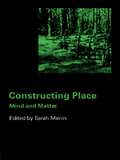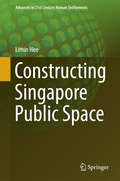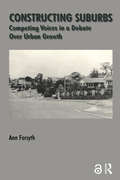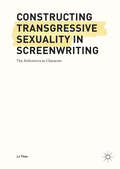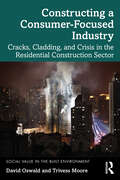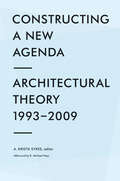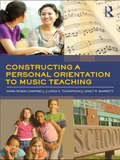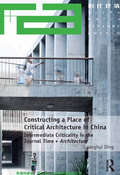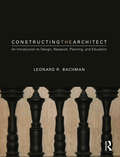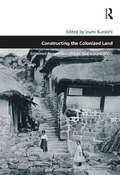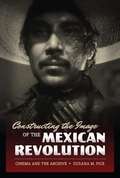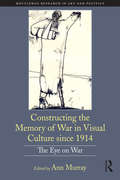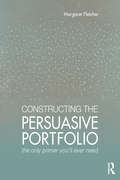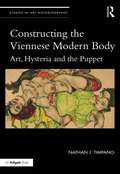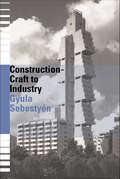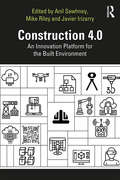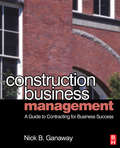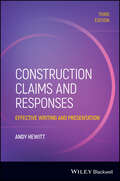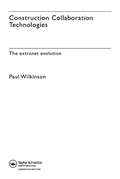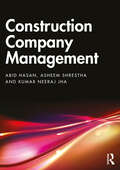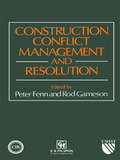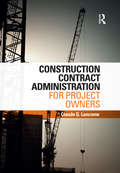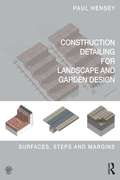- Table View
- List View
Constructing Place: Mind and the Matter of Place-Making
by Sarah MeninThis book is a cutting edge study examining the attitudes to both nature and the built environment of the designer, the client and the society in which an intervention (be it architecture, landscape design or a piece of art) is made. The legacy of the Modernist view of nature and the environment is also addressed, and the degree to which such ideas continue to impinge on contemporary interventions is assessed.
Constructing Public Opinion: How Political Elites Do What They Like and Why We Seem to Go Along with It
by Justin LewisIs polling a process that brings "science" into the study of society? Or are polls crude instruments that tell us little about the way people actually think? The role of public opinion polls in government and mass media has gained increasing importance with each new election or poll taken. Here Lewis presents a new look at an old tradition, the first study of opinion polls using an interdisciplinary approach combining cultural studies, sociology, political science, and mass communication. Rather than dismissing polls, he considers them to be a significant form of representation in contemporary culture; he explores how the media report on polls and, in turn, how publicized results influence the way people respond to polls. Lewis argues that the media tend to exclude the more progressive side of popular opinion from public debate. While the media's influence is limited, it works strategically to maintain the power of pro-corporate political elites.
Constructing Singapore Public Space (Advances in 21st Century Human Settlements)
by Limin HeeThis book presents possible alternatives and interpretations to the well established notion in the mostly western discourse on public space. The discourse on public space as understood in the democratic-rationalist tradition, when applied to the Singaporean public space, would offer much criticism but would not be adequate in identifying alternative processes that allow for transformative potentials in public space. Thus said, the objectives of this book are: 1. To develop a conceptual frame of reference to construct the discourse on Singapore public space 2. To form a preliminary model of Singapore public space through analyzing case studies 3. To understand the modes, methods of production and representation of these public spaces within the rapidly changing urban context 4. To situate these constructions of public space and its possible trajectories within the larger discourse on public space, and to examine the viability of such a construction and interpretive model of public space
Constructing Suburbs: Competing Voices in a Debate over Urban Growth (Cities And Regions Ser. #Vol. 2)
by Ann ForsythExamining the debate between activists and professional planners over the vision of the future of a large growth corridor in Sydney, Australia, this case study maps the history of development from the late sixties to the mid-nineties, during which time serious environmental and financial problems arose. The book outlines five major visions of the future development and examines forms of political, economic, and institutional power applied by the parties in the project, with emphasis on the processes of infrastructure privatization and ecological impacts. The conclusion reflects on contemporary dilemmas about pluralism.
Constructing Transgressive Sexuality in Screenwriting: The Feiticeiro/a as Character
by Lj TheoThis book approaches the construction of complex and transgressive ‘pervert’ characters in mainstream (not ‘art’), adult-oriented (not pornographic) cinema. It deconstructs an episteme on which to base the construction of characters in screenplays, in a way that acknowledges how semiotic elements of characterisation intersect. In addition, it provides an extended re-phrasing of the notion of ‘the pervert’ as Feiticiero/a: a newly-coined construct that might serve as an underpinning for complex, sexual filmic characters that are both entertaining and challenging to audiences. This re-phrasing speaks to both an existential/phenomenological conception of personhood and to the scholarly tradition of the ‘linguistic turn’ of continental philosophers such as Foucault and Lacan, who represent language not primarily as describing the world but as constructing it. The result is an original and interdisciplinary volume that is brought to coherence through a queer, post-humanist lens.
Constructing a Consumer-Focused Industry: Cracks, Cladding and Crisis in the Residential Construction Sector (Social Value in the Built Environment)
by Trivess Moore David OswaldThe old saying ‘safe as houses’ is being challenged around the world like never before. Over recent decades homeowners have experienced the devastating effects of defects like asbestos, leaky buildings, structural failings, and more recently the combustible cladding crisis. The provision of safe and secure housing is a critical starting point to ensure that social value can be delivered in the built environment. However, some of these dangerous defects have resulted in a lack of security, safety, health, well-being, and social value for households and the wider community. The problems homeowners experience go beyond the substantial financial costs for defect rectification. Too often there has been a lack of government and industry support to help the housing consumer through these issues or to prevent them from occurring to begin with. It is time for a rethink and restructure of government policy, support, and industry practices to better protect housing consumers and deliver high-quality and sustainable housing that creates social value. Through evidence-based research and international case studies, this book focuses on the effects that dangerous defects have on the housing consumer. The ongoing construction cladding crisis is used as a primary case study throughout to highlight these implications, with other previous large-scale defect examples, such as leaky buildings and asbestos. Based upon the range of emerging evidence, we propose ideas for policy makers, construction and built environment professionals, owners corporations, and households on how to move forward towards a higher-quality, sustainable, and socially valuable way of residential living. Government policy has long focused on ‘making industry work’ through building regulations and standards. It is now time for greater government and industry focus on the consumer to make ‘consumer protection work’ in the built environment. There is a need to prevent dangerous defects like combustible cladding, better support consumers when defects emerge, and to create buildings for social value rather than minimum standards. Now is the time to build a better future for the end-user.
Constructing a New Agenda: Architectural Theory 1993-2009
by A. Krista Sykes K. Michael HaysThis follow-up to Kate Nesbitt's best-selling anthology Theorizing a New Agenda collects twenty-eight essays that address architecture theory from the mid-1990s, where Nesbitt left off, through the present. Kristin Sykes offers an overview of the myriad approaches and attitudes adopted by architects and architectural theorists during this era. Multiple themes—including the impact of digital technologies on processes of architectural design, production, materiality, and representation; the implications of globalization and networks of information; the growing emphasis on sustainable and green architecture; and the phenomenon of the 'starchitect' and iconic architecture—appear against a background colored by architectural theory, as it existed from the 1960s on, in a period of transition (if not crisis) that centers around the perceived abyss between theory and practice. Theory's transitional state persists today, rendering its immediate history particularly relevant to contemporary thought and practice.While other collections of recent theoretical writings exist none attempt to address the situation as a whole, providing in one place key theoretical texts of the past decade and a half. This book provides a foundation for ongoing discussions surrounding contemporary architectural thought and practice, with iconic essays by Greg Lynn, Deborah Berke, Sanford Kwinter, Samuel Mockbee, Stan Allen, Rem Koolhaas, William Mitchell, Anthony Vidler, Micahel Hays, Reinhold Martin, Reiser + Umemoto, Glenn Murcutt, William McDonough, Micahael Braungart, Michael Speaks, and many more.
Constructing a Personal Orientation to Music Teaching
by Mark Robin Campbell Linda K Thompson Janet R. BarrettConstructing a Personal Orientation to Music Teaching promotes inquiry and reflection to facilitate teacher growth, lifelong learning and a disposition toward educational change. Strongly grounded in current theories and research in teacher education, the text engages readers in analyzing their own experiences in order to conceptualize the complexity of teaching; involves them in clarifying their reasons for seeking a career in teaching; supports their insights, questions, and reflections about their work; and promotes a reflective, critical attitude about schools in general as teachers are urged to think of themselves as change agents in school settings.
Constructing a Place of Critical Architecture in China: Intermediate Criticality in the Journal Time + Architecture
by Guanghui DingFor the past 30 years, The Chinese journal Time + Architecture (Shidai Jianzhu) has focused on publishing innovative and exploratory work by emerging architects based in private design firms who were committed to new material, theoretical and pedagogical practices. In doing so, this book argues that the journal has engaged in the presentation and production of a particular form of critical architecture - described as an ’intermediate criticality’ - as a response to the particular constraints of the Chinese cultural and political context. The journal’s publications displayed a ’dual critique’ - a resistant attitude to the dominant modes of commercial building practice, characterised by rapid and large-scale urban expansion, and an alternative publishing practice focusing on emerging, independent architectural practitioners through the active integration of theoretical debates, architectural projects, and criticisms. This dual critique is illustrated through a careful review and analysis of the history and programme of the journal. By showing how the work of emerging architects, including Yung Ho Chang, Wang Shu, Liu Jiakun and Urbanus, are situated within the context of the journal’s special thematic editions on experimental architecture, exhibition, group design, new urban space and professional system, the book assesses the contribution the journal has made to the emergence of a critical architecture in China, in the context of how it was articulated, debated, presented and perhaps even ’produced’ within the pages of the publication itself. The protagonists of critical architecture have endeavoured to construct an alternative mode of form and space with strong aesthetic and socio-political implications to the predominant production of architecture under the current Chinese socialist market economy. To rebel against certain forms of domination and suppression by capital and power is by no means to completely reject them; rather, it is to use thos
Constructing a Sense of Place: Architecture and the Zionist Discourse (Design and the Built Environment)
by Haim YacobiWhile it is widely recognized that architects and their architecture play a key role in constructing a sense of place, the inherent nexus between an architectural ideology and the production of national space and place has so far been neglected. Focusing on the Zionist ideology, this book brings together practising architects and academics to critically examine the role of architects, architecture and spatial practices as mediators between national ideology and the politicization of space. The book first of all sets out the wider context of theoretical debates concerning the role of architecture in the process of constructing a sense of place then divides into six main sections. The book not only provides an innovative new perspective on how the Israeli state had developed, but also sheds light on how architecture shapes national identity in any post-colonial and settler state.
Constructing the Architect: An Introduction To Design, Research, Planning, And Education
by Leonard R. BachmanUnlike books that concentrate on the monuments and other artefacts that architects produce, Constructing the Architect focuses on architecture as a disciplinary and professional process, an institution of society, and a career of learning and mastery. In doing so, it offers a lens into the architecture of architecture. Mapping architecture as a coherent whole, Leonard Bachman shows that the field must be understood as four mutually reinforcing modes of inquiry: design, research, strategy, and education. Within this framework, he explains how institutions and actors hold differing perspectives on the critical discourse that advances architecture and identifies the various tensions and leverage points for change within the discipline. Featuring over 100 illustrations to support understanding of this highly visual subject, this is an essential introduction for any student seeking to understand what it means to be an architect and to enter the professional discourse.
Constructing the Colonized Land: Entwined Perspectives of East Asia around WWII (Design And The Built Environment Ser.)
by Izumi KuroishiDespite the precipitous rise of East Asia as a center of architectural production since the Second World War, informed studies remain lacking. The lacuna is particularly conspicuous in terms of regional, cross-national studies, documenting the close ties and parallels between China, Taiwan, Japan and Korea during this period. Examining colonized cities in East Asia, this book brings together a range of different perspectives across both space and time. European, Chinese, Taiwanese, Korean and Japanese discourses are examined, with a range of complementary and conflicting views on the design of urban and architectural forms; the political, institutional, religious and economical contexts of urban planning; the role played by various media; and the influence of various geographical, social and anthropological research methods. The diversity and plurality of these perspectives in this book provides an entwined architectural, urban and social history of East Asia, which offers insights into the cultural systems and the historical and spatial meanings of these colonized cities. It concludes that the difficulties in the historical study of East Asia's colonial cities do not so much indicate cultural difference as the potentiality for multiple readings of the past toward the future.
Constructing the Image of the Mexican Revolution
by Zuzana M. PickWith a cast ranging from Pancho Villa to Dolores del Río and Tina Modotti, Constructing the Image of the Mexican Revolution demonstrates the crucial role played by Mexican and foreign visual artists in revolutionizing Mexico's twentieth-century national iconography. Investigating the convergence of cinema, photography, painting, and other graphic arts in this process, Zuzana Pick illuminates how the Mexican Revolution's timeline (1910-1917) corresponds with the emergence of media culture and modernity. Drawing on twelve foundational films from Que Viva Mexico! (1931-1932) to And Starring Pancho Villa as Himself (2003), Pick proposes that cinematic images reflect the image repertoire produced during the revolution, often playing on existing nationalist themes or on folkloric motifs designed for export. Ultimately illustrating the ways in which modernism reinvented existing signifiers of national identity, Constructing the Image of the Mexican Revolution unites historicity, aesthetics, and narrative to enrich our understanding of Mexicanidad.
Constructing the Memory of War in Visual Culture since 1914: The Eye on War (Routledge Research in Art and Politics)
by Ann MurrayThis collection provides a transnational, interdisciplinary perspective on artistic responses to war from 1914 to the present, analysing a broad selection of the rich, complex body of work which has emerged in response to conflicts since the Great War. Many of the creators examined here embody the human experience of war: first-hand witnesses who developed a unique visual language in direct response to their role as victim, soldier, refugee, resister, prisoner and embedded or official artist. Contributors address specific issues relating to propaganda, wartime femininity and masculinity, women as war artists, trauma, the role of art in soldiery, memory, art as resistance, identity and the memorialisation of war.
Constructing the Persuasive Portfolio: The Only Primer You’ll Ever Need
by Margaret FletcherConstructing the Persuasive Portfolio helps you learn the art of designing a compelling and effective architectural portfolio. Margaret Fletcher categorizes the architectural portfolio design process into a step-by-step method that you can manage and understand. The full-color book includes 400 portfolio examples from 55 designers, along with more than 50 diagrams, and a set of 48 design actions that are marked throughout. You will learn how to:-Identify your readership-Collect, document, and catalog your work-Organize your portfolio-Visually structure your portfolio-Design your layout-Manage both printed and digital portfolio formats As your ultimate persuasive tool, your portfolio is the single most important design exercise of your academic and professional career. Constructing the Persuasive Portfolio shows you everything you need to know to create your portfolio and is the only portfolio design book you will ever need!
Constructing the Viennese Modern Body: Art, Hysteria, and the Puppet (Studies in Art Historiography)
by Nathan J. TimpanoThis book takes a new, interdisciplinary approach to analyzing modern Viennese visual culture, one informed by Austro-German theater, contemporary medical treatises centered on hysteria, and an original examination of dramatic gestures in expressionist artworks. It centers on the following question: How and to what end was the human body discussed, portrayed, and utilized as an aesthetic metaphor in turn-of-the-century Vienna? By scrutinizing theatrically “hysterical” performances, avant-garde puppet plays, and images created by Oskar Kokoschka, Koloman Moser, Egon Schiele and others, Nathan J. Timpano discusses how Viennese artists favored the pathological or puppet-like body as their contribution to European modernism.
Construction - Craft to Industry
by Gyula SebestyenThis book provides a unique and comprehensive survey of changes and trends in the construction industry focusing on the post-war years and emphasizing their contemporary and future relevance.
Construction 4.0: An Innovation Platform for the Built Environment
by Michael Riley Anil Sawhney Javier IrizarryModelled on the concept of Industry 4.0, the idea of Construction 4.0 is based on a confluence of trends and technologies that promise to reshape the way built environment assets are designed, constructed, and operated. With the pervasive use of Building Information Modelling (BIM), lean principles, digital technologies, and offsite construction, the industry is at the cusp of this transformation. The critical challenge is the fragmented state of teaching, research, and professional practice in the built environment sector. This handbook aims to overcome this fragmentation by describing Construction 4.0 in the context of its current state, emerging trends and technologies, and the people and process issues that surround the coming transformation. Construction 4.0 is a framework that is a confluence and convergence of the following broad themes discussed in this book: Industrial production (prefabrication, 3D printing and assembly, offsite manufacture) Cyber-physical systems (actuators, sensors, IoT, robots, cobots, drones) Digital and computing technologies (BIM, video and laser scanning, AI and cloud computing, big data and data analytics, reality capture, Blockchain, simulation, augmented reality, data standards and interoperability, and vertical and horizontal integration) The aim of this handbook is to describe the Construction 4.0 framework and consequently highlight the resultant processes and practices that allow us to plan, design, deliver, and operate built environment assets more effectively and efficiently by focusing on the physical-to-digital transformation and then digital-to-physical transformation. This book is essential reading for all built environment and AEC stakeholders who need to get to grips with the technological transformations currently shaping their industry, research, and teaching.
Construction Business Management: What Every Construction Contractor, Builder And Subcontractor Needs To Know (Rsmeans Ser. #67)
by Nick B. GanawayOnly 43 per cent of U.S. construction firms remain in business after four years. Why? Inadequate management, according to the U.S. Small Business Administration. This is surprising because most construction firms are formed by ambitious construction project managers, executives and tradesmen who have excelled at what they have been doing. But as experienced as these entrepreneurs may be, they are not likely prepared to take on the full range of responsibilities forced on them in managing the business of construction in its entirety.While this business failure rate and its causes are based on U.S. experience, available data from a number of other industrialized countries shows they are similar.This book describes in detail what the business side of the construction equation requires of the construction firm owner. The contractor who quickly learns these requirements can identify and avoid or manage around the pitfalls that cause the high failure rate in our industry and put his or her construction firm on a level playing field with the best-run companies in the business. The detailed duties of the owner, whether in the U.S., U.K., Australia or Canada, are a common theme throughout the book. The author, Nick Ganaway, speaks peer-to-peer, and the book is sprinkled with supporting examples from his own experience. He is immersed in the industry and this book is "based on the things I've learned, used, and refined as a light-commercial general contractor in the course of starting and operating my own construction firm for 25 years." The contractor doing $5 million or $50 million or more in annual sales or the equivalent amount in other countries, or the entrepreneur who is just starting up, can use the tried and proven material in this book to build a business that is profitable, enjoyable, and enduring.Additionally, the book devotes a chapter to specializing in chain-store construction.
Construction Claims and Responses: Effective Writing and Presentation
by Andy HewittThe latest and most up-to-date edition of the best hands-on guide to construction claims and claims response preparation In the newly revised third edition of Construction Claims and Responses: Effective Writing and Presentation, renowned construction claims and disputes consultant Andy Hewitt delivers yet another authoritative and practical discussion of how to prepare and respond to construction claims. Covering a variety of different types of claims – including variations, extensions of time, and additional payment – the book demonstrates an effective step-by-step process of building up a claim by breaking it down into manageable sections: contract details, causes, effects, entitlement, and quantum. You’ll find worked examples of typical claims, complete with sample wording, as well as updated and simplified examples of responses, additional detail on cost calculations, and updates to material to maintain compliance with FIDIC 2017. Readers will also discover: A thorough introduction to properly constituted and presented claims, including the establishment of contractual entitlement and comprehensive documentationComprehensive explorations of what constitutes sufficient cause and effect for a construction claimRevised and clarified worked examples of commonly made construction claims and responsesComplete discussions of accurate quantum calculations Perfect for all construction project personnel around the world involved in the preparation of construction claims, Construction Claims and Responses will also benefit those preparing responses to such claims, as well as quantity surveyors, contracts managers, project managers, claims consultants, commercial managers, engineers, architects, and adjudicators.
Construction Collaboration Technologies: An Extranet Evolution
by Paul WilkinsonSince the late 1990s, web-based collaboration technologies (‘project extranets’) have become increasingly widely used within the UK construction industry and are now routinely deployed on the design and construction of thousands of projects. The first book dedicated to the topic, this comprehensive guide will help current and future construction professionals understand, implement and use such systems more effectively. Cutting through the hype and jargon, it offers expert advice and guidance from an industry insider on choosing a software provider, key software features, hosting, legal issues, connectivity, achieving user buy-in and assessing the benefits.
Construction Company Management
by Kumar Neeraj Jha Abid Hasan Asheem ShresthaConstruction Company Management will give readers a detailed understanding of the critical aspects of managing a successful construction company in a dynamic and complex construction business environment characterised by intense competition, supply chain disruptions, and rapid changes in technology, regulations, client preferences, and market conditions.The book will introduce readers to different dimensions of construction company management. The topics covered reflect current business practices in the construction industry, including company strategy and business models, stakeholder management, contract management, resource management, risk management, knowledge management, company finance, digital innovation, organisational resilience, and the regulatory environment. The book also includes much-needed discussions on ethics, integrity and professional standards, and diversity, equity, and inclusion in construction companies. It explores the opportunities and challenges relevant to construction company management in global contexts with the help of case studies from different regions of the world.Providing a concise book on this essential subject, Construction Company Management serves both students and those educators who teach it in their built environment courses. Practitioners will find the theory-informed company management practices discussed in the book valuable and useful in their practical contexts.
Construction Conflict Management and Resolution: An International Perspective (Cib Ser.)
by P. Fenn R. GamesonThis book brings together over 40 papers presented at the 1992 International Construction Conflict Management & Resolution Conference held in Manchester, UK. Six themes are covered, including alternative dispute resolution, conflict management, claims procedures, litigation and arbitration, international construction, and education and the future.With papers from arbitrators, architects, barristers, civil engineers, chartered surveyors and solicitors, this book represents the first multi-disciplinary body of knowledge on Construction Conflict and will act as a unique source of reference for both legal and construction professionals.
Construction Contract Administration for Project Owners
by Claude G. LancomeConstruction Contract Administration for Project Owners is aimed at public and private owners of real estate and construction projects. The book is intended to assist owners in their contractual dealings with their designers and their contractors. Most owners are not primarily in the business of designing and building facilities. The fact that their primary business is not design and construction places them at a disadvantage when negotiating, drafting, and administering design agreements and construction contracts because their designers and contractors use these documents every day. This book is intended to assist owners to redress this imbalance by equipping owners to draft and administer contracts so as to protect their interests. The book is aimed at owner personnel with all levels of knowledge in the business of managing projects. It can serve as a comprehensive introduction to drafting and administering design agreements and construction contracts for beginners. For intermediate level personnel, it can serve as a manual to be read to enhance the reader’s skills in this area. For the sophisticated project management professional, it can serve as a resource to be consulted in connection with very specific issues as they arise on a project.
Construction Detailing for Landscape and Garden Design: Surfaces, steps and margins
by Paul HenseyDesigns for gardens and landscapes need to contain accurate information to ensure that both the designer’s intent is clear and to enable the highest quality constructions. This book contains the elements most often used when detailing surfaces, with key information on standards, guidance and construction that the practitioner must be aware of. Alongside the text are 2D and 3D images with suggestions of measurements, design considerations and materials. Key topics covered in this book are: Vehicular paving Pedestrian paving and patios Steps and ramps Margins, edges and kerbs Drainage channels To be used in conjunction with the book is an innovative online library of freely downloadable CAD (SketchUp format) details which link directly to those in the book. These details are available for the reader to edit, adapt and use in their own designs - and make the task of detailing for projects that little bit easier.
